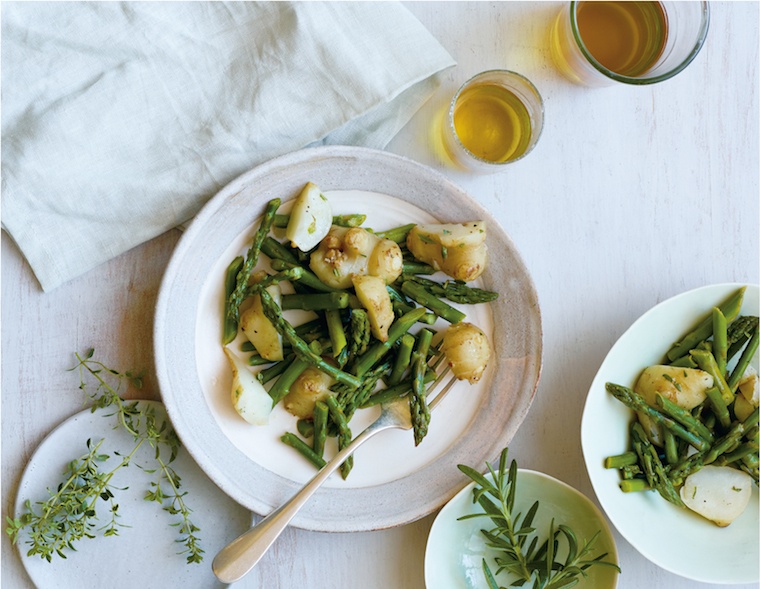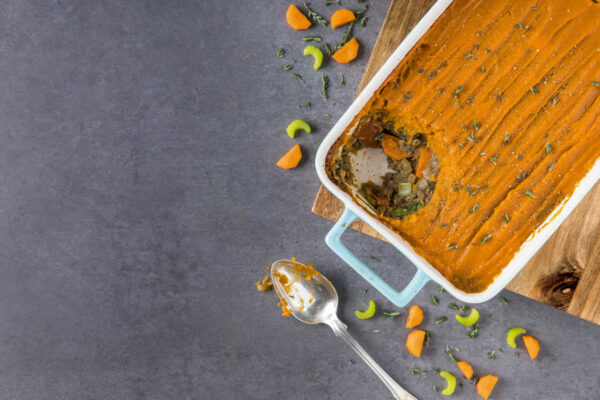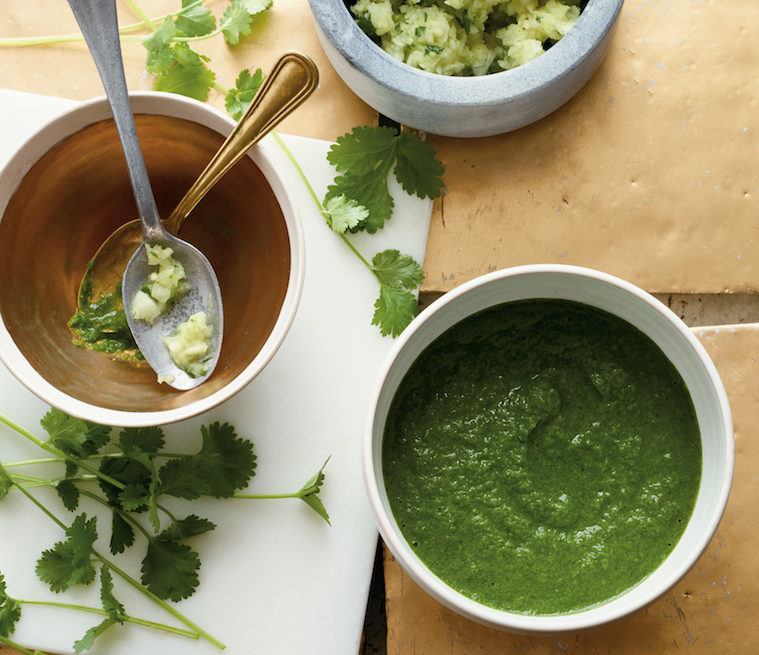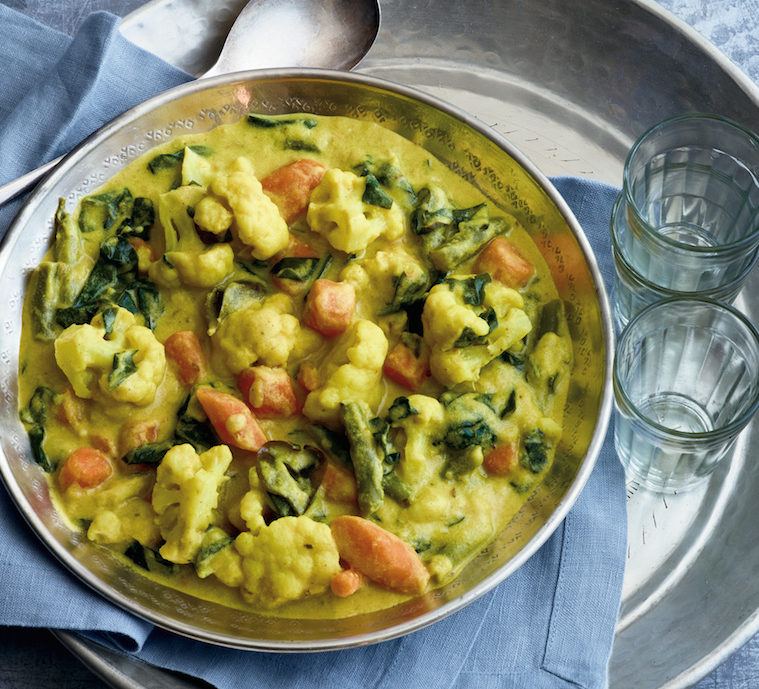The Perfect Dinner Recipe for Your Dosha, According to an Ayurveda Pro
Well, according to the ancient Indian medical tradition of Ayurveda, many of your digestive quirks have to do with your dosha. (That’s your overall energetic constitution, which is said to rule everything from your food sensitivities to your skin type.) Depending on whether you skew vata, pitta, or kapha—you can figure out your type by taking this quiz—certain foods are believed to work in harmony with your gut, while others tend to raise hell. It’s a concept that chef and Ayurveda expert Divya Alter is particularly passionate about—and serves as the basis of her plant-based cookbook, What to Eat for How You Feel: The New Ayurvedic Kitchen.
“I was introduced to [this idea] in India while I was being treated for a severe digestive disorder by an Ayurvedic doctor,” writes Alter, who is also a certified nutritional consultant and the owner of Divya’s Kitchen in New York City. “The doctor told me that there’s no good or bad food in itself—it depends on one’s individual needs at that time.” Talk about words to live by.
"Some people are more airy (vata), some are more fiery (pitta), and others more earthy (kapha). This is why one food or herb...may be good for one, but toxic for another."
As Alter puts it, all foods are a unique combination of the five elements—space, air, water, fire, and earth—as is each person’s body. It’s how the two interact that determines whether an ingredient ends up being your BFF or your worst enemy. “Some people are more airy (vata), some are more fiery (pitta), and others more earthy (kapha). This is why one food or herb may be good or balancing for one, but toxic and aggravating for another.” What makes this even more complicated, she says, is the fact that one’s doshic balance usually shifts with the seasons.
- Ananta Ripa Ajmer, director of Ayurveda at The Well
- Divya Alter, Ayurvedic chef and founder of Divya’s Kitchen
- Sapna Punjabi-Gupta, RD, culinary dietitian and Ayurvedic practitioner
Enter: Ayurvedic cooking. Just like we dress according to the weather, Ayurvedic cooking is a way of preparing food in harmony with what we need during each season, says Ananta Ripa Ajmera, director of Ayurveda at The Well. “Ayurvedic cooking focuses on spiritually charged foods that support the quality of purity and balance in your mind, a term known as sattva in Sanskrit,” she adds. “Sattvic foods are light and easy to digest and give your body strength and stability, both mentally and physically.”
To get your Ayurvedic cooking on, below find six Ayurvedic dinner recipes to add to your meal rotation, including three from Alter’s book, each one deemed particularly beneficial for a different dosha.

{{post.sponsorText}}
Ayurvedic dinner recipes you'll want to add to your spring meal rotation
If you have pitta (or fiery) digestion: Creamy Green Protein Soup
Yields 4 servings
Pitta digestive imbalances: Acid reflux, ulcers, excessive thirst
"I learned this recipe from Vaidya R. K. Mishra, who included it in my autoimmune treatment protocol," says Alter. "It's both nourishing and detoxifying, and when eaten regularly, this quick soup can replenish nutrient deficiencies, boost immunity, and restore vitality. To me, it offered enhanced digestibility of the protein and minerals I was looking for in raw, green smoothies." This soup is suitable for everyone. If you eat it a few times a week, switch up the greens to vary the nutrients and taste.
Ingredients
Soup
2 tsp ghee or olive oil
1 tsp Cooling Masala (recipe below)
1 tsp salt
1/4 tsp ground turmeric
1∕8 tsp fenugreek seeds
1 cup crumbled paneer (fresh, soft cheese)
1 pound leafy greens such as chard, beet greens, collards, spinach, kale, and/or amaranth
1/2 cup fresh parsley leaves
Fresh lime juice (to garnish)
Cooling Masala
3 Tbsp coriander seeds
3 Tbsp fennel seeds
1 tsp cumin seeds
1 tsp ground turmeric
1 tsp dried rose petals or buds
1 tsp dried rosemary
1. In a 3- to 4-quart saucepan, combine 2 cups water with the ghee, masala, salt, turmeric, fenugreek, and cheese. Bring to a simmer over medium-low heat and cook for 15 minutes.
2. While the cheese is cooking, prep your greens: Wash, stem, and tear them—this should yield about 8 packed cups. Gradually add the greens and parsley, turning them over until they wilt but still retain their vibrant green color, 3–5 minutes. Turn off the heat and leave the soup uncovered to cool it down a bit.
3. Transfer the soup to a blender and mix to a smooth and creamy consistency. Reheat the soup if needed.
4. Garnish with lime juice and serve hot.
For the Cooling Masala
1. Place all the ingredients in an electric grinder or spice mill and crush to a fine powder. Store in an airtight jar away from light.
Notes
- For vata (airy) digestion: Substitute Digestive Masala (recipe below) for the Cooling Masala, using the same instructions to prepare it. Add 1/4 tsp black pepper and a drizzle of olive oil in step 4.
- For kapha (earthy) digestion: Substitute Energizing Masala (recipe below) for the Cooling Masala, using the same instructions to prepare it. Add 1 Tbsp grated fresh ginger in step 1.
Digestive Masala
2 Tbsp coriander seeds
2 Tbsp fennel seeds
2 tsp cumin seeds
2 tsp kalonji seeds (AKA black seed)
1 tsp ground turmeric
Energizing Masala
1 Tbsp coriander seeds
1 tsp fenugreek seeds
1 tsp cumin seeds
1 tsp ajwain seeds
1/2 tsp powdered ginger
1/2 tsp ground turmeric
1/4 tsp black peppercorns
1/4 tsp cinnamon granules or crushed cinnamon bark
1/4 tsp black cardamom seeds (from 1 or 2 pods)
1/4 tsp salt
If you have vata (or airy) digestion: Mixed Vegetable Curry in Cashew Sauce
Yields 4 servings
Vata digestive imbalances: Constipation, gas, bloating
This colorful curry recipe is very adaptable. You can vary the combination of vegetables according to taste and availability—try summer squash, asparagus, Brussels sprouts, peas, sweet potatoes, broccoli, or whatever vegetables you have left in the fridge before your next shopping trip. Alternatively, you can roast some of the vegetables and add them when the rest are almost cooked.
Ingredients
1⁄4 cup cashews, soaked overnight, drained, and rinsed
2 Tbsp ghee or coconut oil
1 tsp ground turmeric
1/2 tsp cumin seeds
8 curry leaves (see note)
2 tsp minced fresh ginger
1 small green Thai chile, seeded and minced
1 tsp ground coriander
1/2 tsp dried thyme or rosemary (crushed)
1/8 tsp asafoetida (optional)
1 1/2 tsp salt
3 medium taro roots, peeled and cut into 1/2-inch cubes
1 cup carrots cut into 1/2-inch cubes
1 cup green beans chopped into 2-inch pieces
1 cup cauliflower broken up into 1-inch florets
2 packed cups chopped spinach
2 Tbsp chopped fresh cilantro or parsley
1. Rinse the soaked cashews and blend them with 1 cup water to a smooth cashew milk.
2. Heat the ghee in a 2-quart sauté pan over medium-low heat. Add the turmeric and toast for 15 seconds, then include the cumin seeds and continue to toast for a few more seconds, until the seeds darken a shade and release their aroma. Mix in the curry leaves, ginger, chile and toast for a few more seconds, then the coriander, thyme, asafoetida, if using, and salt. Immediately pour in the cashew milk and bring to a boil. Introduce the taro roots, cover, reduce the heat to medium-low, and simmer for 10 minutes. Introduce the carrots, green beans, and cauliflower, mix well, and continue to cook, covered, stirring occasionally, until the vegetables are tender, about 20 minutes. If the curry begins to dry and stick to the bottom of the pan, use 1⁄4 cup more water. Add the spinach and cook for 5 more minutes. Add a little water if you like your curry more liquid.
3. Fold in the chopped fresh herbs and serve hot.
Notes
- Curry leaves can be purchased in Indian or Asian grocery stores. They'll keep for up to two weeks if you store them refrigerated in an airtight container. Dried versions are significantly less fragrant, so double their quantity in a recipe.
- For pitta (fiery) digestion: Skip step 1 and substitute coconut milk for the cashew milk. Replace the ginger, chile, and asafoetida with 1/2 tsp Cooling Pungent Masala (recipe below) in step 2.
- For kapha (earthy) digestion: Increase the ginger to 1 Tbsp and add one more green chile in step 2.
Cooling Pungent Masala
4 tsp fennel seeds
4 tsp coriander seeds
1 tsp black peppercorns
1 teaspoon Sucanat, raw cane sugar, or coconut sugar
1. Place all the ingredients in an electric grinder or spice mill and crush to a fine powder. Store in an airtight jar away from light.

If you have kapha (or earthy) digestion: Sunchoke and Asparagus Salad
Yields 4 servings
Kapha digestive imbalances: Fatigue after eating, loss of appetite
"This is among the most delicious Ayurvedic dinner recipes out there. The sunchoke has an bittersweet taste with delicate, almost artichoke-like flavor, which I find very pleasant and refreshing," Alter says. "Although you can eat sunchokes raw, I highly recommend lightly cooking them to reduce their exuberant airy qualities. Peeling these tubers is preferred but more time-consuming (and patience-testing). Scrub them well with a vegetable brush when you’re cooking them in a hurry."
Ingredients
Salad
2 cups sunchokes, scrubbed and chopped into 1 1/2-inch pieces (about 12 oz.)
1 bunch asparagus, fibrous stalk ends trimmed and spears cut into 2-inch pieces (about 2 cups)
Dressing
1 tsp black sesame oil or olive oil
1 Tbsp fresh lime juice
1 Tbsp ginger juice (see note)
1 tsp fresh thyme leaves or 1/4 tsp dried thyme
1/2 tsp salt
1/2 tsp finely minced fresh rosemary leaves
1/4 tsp freshly ground black pepper
1/4 tsp ground nutmeg
1. Steam the sunchokes in a steamer basket set over a pan of simmering water for about 10 minutes, until they are crisp-tender; remove from the steamer to a serving dish and set aside. Steam the asparagus for about 5 minutes, until tender, and plunge into cold water to refresh; drain well. Add to the dish with the sunchokes.
2. Whisk all the dressing ingredients in a small bowl, pour over the vegetables, and let them marinate for 5 to 10 minutes. Serve at room temperature.
Notes
- To make ginger juice, grate a 2-inch piece of ginger and squeeze the juice from it in your hand.
- For vata (airy) digestion: Increase the oil to 1 Tbsp and omit the nutmeg; substitute parsnips for the sunchokes.
- For pitta (fiery) digestion: Omit the ginger juice and increase the oil to 1 Tbsp.

Sweet potato and lentil shepherd’s pie
When you’re craving something warm and grounding, try this vegan shepherd’s pie starring sweet potato and lentils from Highest Self podcast host Sahara Rose’s book, Eat Feel Fresh: A Contemporary Plant-Based Ayurvedic Cookbook, which is filled with delicious Ayurvedic dinner recipes. Start by cooking the sweet potatoes and lentils separately and sauteing carrots, onions, celery, and garlic together. Then pop everything in the oven for 20 minutes to bake.
Kitchari
“Kitchari is a great example of Ayurvedic cooking in the sense that it contains all of the six tastes in it, which makes it a balanced meal, Ayurvedically-speaking,” says Ajmera. “This recipe imparts strength to your body, is nourishing, and promotes an easy regular bowel movement—a key sign of healthy digestion. Kitchari is also a sattvic meal, which calms and balances your mind.”
Turmeric lemon rice
This turmeric lemon rice recipe by Sapna Punjabi-Gupta, RD, a culinary dietitian and Ayurvedic practitioner, is full of flavor and spice and makes for a great addition to many Ayurvedic dinner recipes. Punjabi-Gupta recommends soaking some long-grain basmati rice for 15-30 minutes to make it easier to digest. You’ll also need black mustard seeds, raw peanuts, curry leaves, green chilis, and fresh cilantro to garnish.
Dining rituals for Ayurvedic dinner recipes
According to Ayurveda, how you eat your Ayurvedic dinner recipes is just as important as what you eat when it comes to bringing harmony to the body and mind. That’s why Ajmera recommends turning each Ayurvedic dinner recipe (and every meal, really) into a pleasurable dining experience. “It is believed that digestion begins at the first sight of your food, and that your food and environment while eating should appeal to all of your senses for optimal digestion,” Ajmera says. “The [Ayurvedic] texts recommend eating on dishes and vessels that appeal to you, with beautiful utensils, soft music in the background and eye-catching centerpieces like flowers, lit lamps, and so on."
Your mental state too can impact digestion, Ajmera says, so chanting inspiring mantras before you eat can help prepare your body to experience the food in an uplifting manner. Also, chewing your food slowly help you savor and digest each bite, she says. Once you’re finished, Ajmera recommends concluding the Ayurvedic dining ritual by sitting quietly with your eyes closed for a couple of minutes and taking it all in.
Oh hi! You look like someone who loves free workouts, discounts for cutting-edge wellness brands, and exclusive Well+Good content. Sign up for Well+, our online community of wellness insiders, and unlock your rewards instantly.
Loading More Posts...

